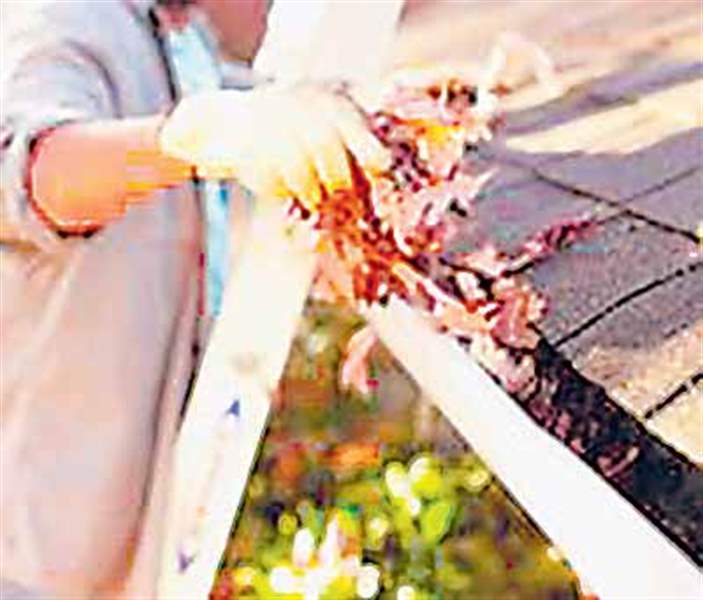
Home prep is key as warm weather offers other challenges
4/3/2014
Clean the gutters of leaves and debris.
As northwest Ohioans fling open their doors to run from the house to shed cabin fever, they might want to remember to examine door screens and the rest of the house to get it back into shape after such a rough winter.
“The biggest thing right now is checking screens for holes so no bugs get inside,” said Brian Yeager, a manager at Neighborhood ACE Hardware in Sylvania.
Bugs? Really? Yep. They come with warm weather, and though it seems a long time coming, warmer weather is coming, and with it comes chores homeowners must do to prepare their houses for spring and summer.
If you cleaned leaves from the gutters last fall, Mr. Yeager said to check them again this season.

Clean the gutters of leaves and debris.
“With the rain storms coming, check the seams to make sure none has split due to the ice,” Mr. Yeager said. Also, “Make sure the down spouts are clear and pointed away from the house. Use extensions to make sure water flows from the house and not into the basement.”
Safety is foremost, as pointed out by William Sinz, manager at Home Depot on West Alexis Road.
“For damaged gutters, homeowners without roofing experience shouldn’t do more than simple tasks, like securing nails and adjusting spouts. Beyond that, it’s safer to get a professional’s help,” Mr. Sinz said.
Spring and summer is no time to ignore the furnace, either. Jeff Chamberlain, the owner of Pro Hardware in Whitehouse, said furnace filers in summertime should be changed every 30 days.
“If you use a pleated filter in the winter, in summer you want to use the fiberglass filter,” Mr. Chamberlain said. “It allows for more air flow so the furnace motor works easier.”
Ms. Sinz suggests homeowners check the air conditioner for damage that needs repair and to make sure the airflow for outside units is not restricted by dirt or anyting else.
“If Freon is low, there may be low airflow in vents. Air coming from the vents will feel warm, there may be water on the floor near your unit, or it may take longer for your house to cool,” Mr. Sinz said. He added, “If Freon leaks, a professional should fix any Freon leak, test the repair, and charge the system with the correct amount of refrigerant.”
Programmable thermostats are important in the summertime too.
“Turning back your thermostat 10 to 15 degrees for eight hours a day can save up to 15 percent a year on your heating and cooling bill,” he said.

The Nest Learning Thermostat.
That’s why it’s vital that homeowners are mindful of home energy efficiency in spring and summer as they are during the colder months.
“You may need to reseal your home’s ‘envelop,’ ” Mr. Sinz said. “First check for air leaks, which you can do a number of ways, from feeling for air flow around windows and doors with your hand, to using a leak detector, to hiring a contractor to conduct a blower door test.”
For small air leaks, caulking and weather-stripping seams, cracks, and openings will solve that problem.
“Consider using a weather-resistant foam sealant if sealing in a visible place. It resists moisture and can be sanded, painted, and stained for a more appealing look,” Mr. Sinz said.
And take a good hard look at your home’s siding. Mr. Sinz said cold weather makes vinyl siding brittle and susceptible to cracking or breaking apart.
“Cracks allow moisture to penetrate the inner siding of your home, which can create mold and mildew, resulting in serious problems and structural repairs for the house,” he said, adding that discoloration could be a sign of water damage. “Remove mold and dirt with a deep cleaning. Create a solution of hot water and outdoor bleach to remove stains. For larger mold infestations, consult a professional cleaning service.”
While damaged areas of siding can be removed with a utility knife, Mr. Sinz suggests homeowners check with the siding manufacturer for instructions on how to properly install new boards. Contact a professional contractor if damage is suspected to be on the inner siding of the house, he said.
Certainly homeowners remove obvious obstructions from steps. But where steps are made from wood, a close look might reveal damaged wood from using shovels to clear winter’s snow and ice. Mr. Yeager of ACE Hardware in Sylvania said sanding splinters will eliminate bigger problems.
And don’t overlook examining the wood deck, Mr. Yeager said, as “When shoveling a wood deck, people splinter them a lot.”
Mr. Sinz said if the damage on the deck is in a small area, only that section needs replacing, not the whole board.
“Use a hammer to pat down any nails that may have popped up over time,” Mr. Sinz said. He added that there are products on the market that are 10 times thicker than ordinary paint that will fill cracks up to a quarter of an inch and will also resurface concrete and wood.b8779a0a-983b-4191-ba10-2fbd851e2caf
Contact Rose Russell at: rrussell@theblade.com or 419-724-6178.